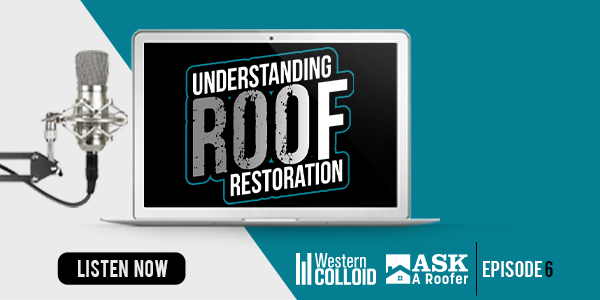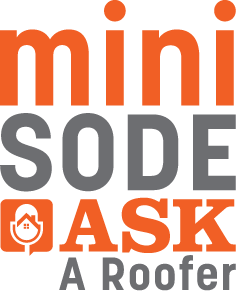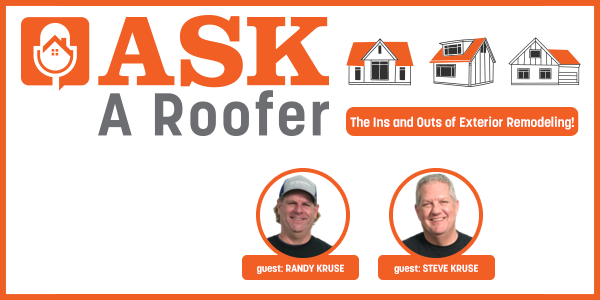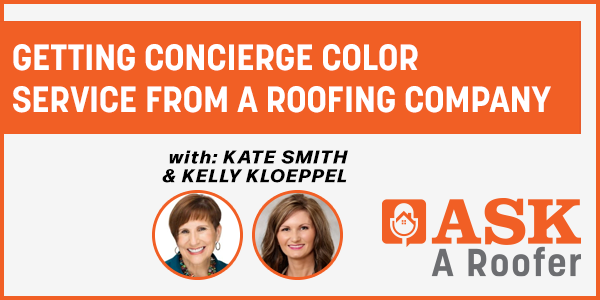Understanding Roof Restoration Episode 6 - Best Practices For Today’s FARR Systems - PODCAST TRANSCRIPTION
April 11, 2023 at 6:00 a.m.Editor's note: The following is the transcript of a live interview with Greg Lavati and Hal Leland from Western Colloid. You can read the interview below, listen to the podcast or watch the video.
Karen Edwards: Hello, and welcome to the Understanding Roof Restoration Podcast. I'm your host, Karen Edwards, from askaroofer.com. The Understanding Roof Restoration Podcast dives deep into the topic of restoring roofs. As the popularity of roof restoration continues to grow, there are many questions that arise. With a wide variety of roofing systems on existing buildings and many available restoration options, we turn to the experts at Western Colloid to answer your questions on roof restoration.
Greg Lavati, Hal Leland, and the team at Western Colloid have been manufacturing and installing these systems for more than 50 years, and they have seen it all. We will tackle a different topic each month and answer questions submitted by you, our listeners.
Hello, everyone, and welcome to another episode of Understanding Roof Restoration. I'm your host, Karen Edwards, and I'd like to welcome back Greg Lavati and Hal Leland from Western Colloid. Welcome, guys.
Greg: Welcome, good greetings. Good to see you.
Karen Edwards: The time goes by so fast. It seems like we've just recorded an episode, and now here we are with another one. This one I'm really excited about, because we got a sneak peek of this at the International Roofing Expo in Dallas recently. Western Colloid has rolled out a program called Best Practices for Applying a Fluid Applied Roofing System. It's really important, as we've chatted before, about understanding the system and doing it right. I'd like you guys to talk a little bit about why education is so important for you, educating contractors, so important for you as a manufacturer.
Greg: Great. Yeah, we're pretty excited about our best practices because it goes beyond Western Colloid's best practices, even though that is what it's centered around, it really, we feel it's kind of like for those of you that come from the old computer days, if you know what open source software is, this is an open source program. In other words, it's out there for people to use, whether you're our customer or you're just a coating contractor trying to do things right.
Much of this that we're presenting is centered around what we do. We start from equipment to use, hoses. If you go to our best practices page, you can see everything to even hooking up to the tankers. As I look at our page, if you look down the different things that you can click on, hose filters for motion and acrylic, so filters you can use in your hoses to not have plug ups, complete job site set up for a coating job. What's the best way to set up a job where on a building, and how to stage your people and your equipment, tanker to spray rig set up, because we use tankers. Not everybody uses tankers. This is Western Colloid-specific, parts to have on hand for emulsion, and acrylic, and spray rigs, and parts for your spray bars, and different things that are just handy.
Prepping your pumps before you go out there, instead of getting to a job and spending an hour and a half getting everything ready, when you could be working on the roof if you'd have prepped it before you got out there. Basic tools you need for coating application, whether it's a spraying, or rolling, or in the kind of gloves and scissors when you're doing a polyester fabric reinforcement, all the things you need instead of going out, starting a job and saying, "Well, now what do we need this morning?" Sending guys to the Home Depot or someplace, spending an hour to two hours wasting time.
What we recommend in spray rigs for our materials and in general, how to fabricate a stinger to pump material out of a drum, how to use totes and hook up to them, how to use drums and how to hook up to them, using the correct hoses. Working with buckets, quick tips on speeding up bucket application on a roof, emulsion wands that we use for our sprain or asphalt emulsion, and then spray bars that are used for higher pressure acrylics. Just a whole list of things that we're putting, and more coming as we build them, as we go.
Conversations with our two field technical guys that have 30 plus years out there in the field, and work with contractors that have even more information that we'd like to pass along. It's a lot of information, and we think it's important information. We're really excited to share it with contractors. A lot of it pertains to even building owners. It's things to ask when you're working with a contractor, if you see that they understand the things that we're explaining, that often, they can understand they have the right contractor for their building.
Karen Edwards: It sounds really like it's a labor of love, because not only, of course, you're a manufacturer and you're helping your systems be installed properly, but this is more to elevate and educate the industry in general, I think ...
Greg: Right.
Karen Edwards: ... On these best practices. Hal, I know that you, you're out in the field a lot and working with contractors. What kind of feedback have you gotten from the kind of support and education that you guys provide?
Hal: Well, our guys, that's all they do. I think for me, it starts with waking up and making your bed and having a coffee. Then all of our guys are four men crews. You've got a foreman, a second man, and they're basically interchangeable. You got a third man who's learning all the parts of these assemblies and systems, and how to get all materials and pumps working. Then you've got a fourth man, who's below everybody else, but they're all working together as one group to get as many squares on in a day as possible, to have all the right materials ready, equipment ready.
It's just always been a team effort with Western Colloid, and a small team. Greg likes to call it the Navy Seals of the roofing world, because we're a tight-knit group, and we come in, we're very quiet. We don't leave a big footprint, and we leave that day and no one even really knew we were there.
Karen Edwards: It makes a big difference.
Greg: Yeah.
Karen Edwards: It makes a big difference.
Greg: One of the things you'll see if some of the interviews with Tim Ford and Chris Ford, two field technical guys that go out and train with crews, is one of the first things they say is, "Do you have enough guys?" You probably have too many guys is in reality. If your everyday roofer doing a commercial built up or mod bit and some of those practices, they attend to attack the roofs in larger groups, it's heavier lifting. There's more guys on a roof. They'll kind of do the same thing, because it might be a big job, it might be two 3000 squares. They're going to go out there, and they've got 10 guys. Again, it's a four man, if you're working with tankers, it's a four man crew. If you're working out of totes, and it might be a five man crew, but not a 15.
There's oftentimes, we'll show up to jobs to help them out and they've got 10 or 12 guys on a roof, more than they need for sure. It is always, we think, of value to take a look at some of the stuff we have in our best practices and why we say what we do. We don't just come up with this last year. We came up with this over the 40 years of our life, and working with contractors. Like Hal said, most of our guys that we work with every day do this every day. We glean a lot of things from them and learn, and then we absorb them.
One real quick thing that always amazed me is I'd go out on a commercial roof that has skylights on it, and I will see guys cutting out pieces of [inaudible 00:08:59] and taking masking tape and masking up all these skylights. I might have 100 skylights on a roof, but we learned early on from one of our really good contractors, you've got a roll of 20 inch stretch wrap. You run around a skylight by just stretching, crisscross, crisscross around it. Two guys can do 100 skylights in an hour on a roof, where they'll take three men crew doing two days masking skylights. That kind of production work, it has nothing to do with our materials.
Only a little bit of what we do has to do with selling Western Colloid products. It just has to do with doing the roof right, getting it on right, and saving the contractor, which in turn saves the business owner money. If you get it done effectively and the contractor can do it with less time, better practice, less cost for shutdowns and what have you, he's happier, and he's happy with Western Colloid. We showed him how to do that. We kind of come in the back door in some of our sales efforts. It's not an in your face, "Hey, our product is better, use it." It's, "Hey, we're the whole package, and here's part of it." We think this is a real important part, not just for us, but for the industry.
Karen Edwards: I love that skylight example, because you have people, you guys have been doing this for a really long time, so you've seen it all. That saving a couple of days, taping off those skylights by just doing it this way, wow. That's really impressive. I know that you have put together the effort to collect all of these tips, best practices, information, and it's all on the website.
If someone visits westerncolloid.com and then goes over to the news and blog section, there is a link there to access the page that has lots of videos and useful information. I'd like to hear a little bit about the brains behind it. You mentioned Tim and Chris.
Greg: Right.
Karen Edwards: Tell me a little bit about them and why they wanted to do this.
Greg: I'm going to tell you that, but I left out one part that we're going to be adding here and it pertains to Hal. That is what to ask, what to have in paperwork or in backup when you're going to go do a job, if there's a building owner calling out for a spec or an architect or a consultant, have the specs, have the paperwork. If you need backup of ratings, because oftentimes, that's where Hal comes in, having the FM backups. We get people call us all the time, "Do you have an ICCES number? Do you have a FM approval? Do you have fire ratings?"
Have all that stuff if you're starting an important job where you're going to be questioned about it. That's another part which is yet coming to our best practices, but that's something else, and that's something that Hal works on extensively, and something we can help advise him on. Tim and Chris, Tim Ford was a longtime applicator of fluid applied systems, especially polyester and emulsion and acrylic systems for many years. From starting on the roof, sweeping to clean it up before they got started years ago, to becoming a foreman, to becoming the job superintendent for the largest coating applicator in the west coast.
He had 25 years and he became our technical advisor. He loves to go out and teach guys how to do it, work with them. Our guys get their hands dirty. They're not out there with their fingers pointing, "Hey, do that a little differently," and pointing at it. They're dirty. They're down there in the trenches with him. Chris Ford is his nephew who also worked under Tim earlier in his career for about a decade, and then went off and did something, then he came back with us, and has become the same kind of a guy.
He's out there, working with them, and they love to, matter of fact, they more than love. You can see a couple of their conversations we have up there on the website, but they talk about, "When we get to a job, here's what we find, and here's frustrating, and here's what you could be doing." They have a love of putting on these kind of systems and seeing guys do it right and being successful at it.
Karen Edwards: Wow.
Hal: Building on that, Chris Ford and Tim Ford, we put them on airplanes almost every week and they're flying across United States. Chris Ford just came up to Reno, Nevada, well, before we had rain, but he packs a bag, and it's on the airplane. He checks it, because it's got knives in it and scissors in it. He can't carry that on an airplane, but he's got everything he needs to do to hit the job running.
He's like Greg said, they're not up there pointing their fingers. Chris has got an extra change of clothing that's going to get dirty. They're ready to go. They come and they're expecting our crews to be as ready as he is. It's just really refreshing. These guys are so invested in it. We have the best support team, I think, as anyone I've ever seen in the manufacturing business. It's just so impressive.
Greg: Yeah.
Karen Edwards: Well, I love it because they have so many years of experience and now they're sharing all of that knowledge with other contractors in the field, but they're still able to get their hands dirty, because I'm sure they miss it just a little bit. That keeps them in touch with it.
Greg: Oftentimes, when we have somebody out of the area that is really interested in getting into installing fluid applied systems, and it may or may not be practical either to get out there, work with their crews, we've multiple times flown two of their crew guys out to the west coast and put them on crews of some of our better contractors, and say, "Hey, work with these guys for one day a week," or however long they want to spend time with them. When they go home, they're educated at it.
We have a couple of ways of doing that. We have some contractors that don't mind sharing the knowledge and sending guys out from other areas to learn, and learn the right way, or at least what we think is the right way.
Karen Edwards: Yeah, no.
Hal: It's common practice for our techs to double the production of these guys that are currently, we're working out of buckets or mostly out of buckets and drums. I haven't seen one crew that our guys haven't doubled their production, at least, in a single day.
Karen Edwards: Wow.
Hal: These are tricks that are just, like Greg said, we're not afraid to share it. It's not our deal.
Karen Edwards: It's not a secret. It's not secret. You want to help everyone be successful and be productive.
Greg: Oftentimes, shortcuts for contractors that are unfamiliar with things are use less material so I can get it on faster, which saves me labor. That's not how we do it. We say shortcuts and faster ways of doing things, not to cut the system down or the product down, just that there's sometimes better ways to do things. There's always been that, I don't care if you were an old, built up guy with a kettle and hot asphalt, the guys that knew how to do it better got it done faster, and did the bigger jobs, and were more competitive and made money at it.
There's always somebody that knows how to do it maybe a different way, as long as you're open to it. If you can be open to seeing things a little differently, then we like to share you with it. The other thing is that comes up is that we often train guys, but I've mentioned this before, but labor is an issue, and labor comes and goes. This guy who was here today and now he's working for so and so, or you get him on a different crew, he's putting down single ply, he's not working on your coating crew. That's another reason that we have this best practices page is, you got a new coating job coming up, and your crew hasn't done it for a little while.
Maybe you have one guy that knows what he's doing. Well, send the guys to our page at a computer in your office and them go over all these things. It'll remind them of how to hook up to a tote, how to build a stinger to go down in a drum, how to put what kind of a filter if you're going to use a big emulsion tank, so you don't get plug ups in case, all the thing. What size of hose should I be taking out to the job? They can get a refresher course by just looking at some of our best practice page links, and maybe without full training.
Karen Edwards: Yeah. We mentioned, or you guys mentioned in the press release that came out the week of IRE announcing this, that there was an individual who watched one of the videos, and loved it so much with all the information in there, that he watched all of them. It was kind of binging on your best practice videos. Then he went out and got his crews and his installers, and said, "Hey, you all are coming in here and we're going to watch these, because it was really great information."
Greg: Right, right.
Hal: Can you imagine if you got a project coming up tomorrow and your crews come in at 3:00 PM, and you set that crew in front of a monitor? For an hour, you watch all these films what they're going to be doing tomorrow. They take that home at four o'clock, and they have dinner with their family, but they're thinking about that all night. That stuff's in their mind and it's preparing them. It's just brilliant, I think.
Karen Edwards: It is, and I'm glad you mentioned that for an hour, because this isn't eight, 10 hours. These videos are brief and educational, and they don't drag. They're interesting.
Greg: I'll put one big disclaimer out there is we show a lot of things the way we do things and the way we have contractors that do things, but always keep in mind, that's subject to your company's safety regulations, the local safety OSHA, and that we're not asking you to do anything that you shouldn't be doing. If you see anything on there that you think is, "Oh, I'm not sure I can get away with that," well, we apologize. Maybe it's in different parts of the country or different areas.
Always mind your local safety regulations of that and do things right. We try to keep that in mind also. We don't want to mislead anybody about doing something that they're uncomfortable with or whatever, and I don't think we do, but I just want to have that little disclaimer out there that ...
Karen Edwards: Sure. Yeah. I think that ...
Greg: ... that safety practices are ...
Karen Edwards: ... that you guys have done well is you talk about job site safety, about cleanliness, about staging. It's not always just about the installation or the rigs or the hoses, or how to clean up afterwards is kind of a thing, and get it ready for the next day. You've got information out there on that, which I'm sure has been well received too.
Greg: Yep. Yeah. I'll give you another real quick example of something that we just kind of blew a contractor way on. I was on a job with Tim Ford, and the first thing we did when he got up on the job with his contractor is he had him do right where the ladder went up, right next to the ladder. He had him do about 20 or 30 squares of area right there. The guy says, "Why are we doing this? Why aren't we pulling the hoses up to the far end of the roof? Why are we," he says, "You'll see when we're through."
At the end of the job, as they got to that ladder area, if they hadn't done that area right next to the ladder and got it all ready and almost finished, they would've had to shut down that day, because they had nowhere to go. They had to get off the ladder, they couldn't finish the roof. They had hoses laying around. They'd have been back there another day to finish up the area where all their equipment was staged. In this case, they just moved over to the area next to the ladder. They'd already sprayed. They finished up and got off the roof.
There was a four men and a full day they saved, just by a little job site set up and planning. Those kind of things are some of the stuff that we share.
Karen Edwards: Yeah. Those are things that you just might not think about it. We've always done it this way. We always have to come back that last day to clean up and get our stuff down. By just doing that one little step, I like that story. Whenever we can take real life applications and demonstrate that it works, that's always a good thing.
Recording: This podcast is brought to you by Ask A Roofer and Western Colloid, Fluid Applied Roofing. When you're looking for answers for your roof, what better place than askaroofer.com? If you are looking for answers on restoring your commercial, industrial, or low slope roof, look no further than Western Colloid. For over 50 years, they have been bringing old roofs new life.
Together, we're helping contractors, building owners, property managers, architects, engineers and consultants. Choose the best commercial roofing system. Find Western Colloid today on askaroofer.com.
Karen Edwards: We are going to be continually updating the best practices, correct? This is not like a, "Hey, we rolled this out. There it is on our website." You're going to be adding new stuff throughout the year as we move along, yes?
Greg: Yep.
Hal: Yeah, I just want to make a point to any contractors listening or building owners, these videos we make are, they're not highly quality. They're not Hollywood videos. These are our guys making videos. They're real world, they're quick, they're bright, and very informative. Just don't be afraid to look at them.
Karen Edwards: They're authentic. They're real. They're happening out in the field. Like we said, it doesn't take long to watch. Pull it up over a lunch break, before you start your day, or at the end of the day. Check it out, like I said, westerncolloid.com, under the news and blog section, you'll see a link for the best practices program. Anything else to add that I didn't ask you about yet with the best practices? Did we cover it all?
Greg: I think we covered it, and we appreciate the opportunity for the podcast. We appreciate being able to reach the billions of large people.
Karen Edwards: Yeah. One of our goals with this podcast really is to provide education. It's a great example of we're taking, "Yes, we've got this best practices program in place. We're going to be continually adding to that. We're going to be continuing this podcast on a monthly basis. Our goal is to answer your questions, whether you're a building owner, you're a contractor, we want to know what your questions are."
Greg: I'm going to throw out one little plug for the RCMAA, Roof Cody Manufacturers Association, which we're a member of. Many of our fellow roof coating manufacturers are. RCMA has a new education program to almost get a certificate or whatever. I think it's got to have three panels about roof coatings. It's very general. We covered lots of ...
Hal: Different chemistries.
Greg: Chemistries and what have you, you got to cover acrylic and urethanes and silicones and the whole nine yards. It's more general, and it's mostly about coating. Ours is more in the membrane, fluid applied membrane, but it's something very good. If you want to go to the RCMA, you can pay a fee and you can have your guys also take the different module, or one of the three or all three of the modules at the RCMA and get their education in coating technology.
Karen Edwards: Excellent. I know that our sister site, which is Roofer's Coffee Shop, has a directory for the Roof Coating Manufacturer's Association. All the information on that training course can be found there. Definitely there are resources. Western Colloid, thank you for really pulling together this best practice program. As I mentioned earlier, this podcast is about education, it's about answering your questions, and we want to know what your questions are.
Visit askaroofer.com. You can submit your questions there, and if we use your questions, I heard you might be getting a little gift. Think about what you want to know about roof restoration and send us those questions. Next month, our topic is going to be understanding solar retrofits, which is very interesting. There's a lot happening with solar, especially with this new legislation that was passed that offers some additional incentives. More people are interested in it. We want you to tune in next month for that topic. In the meantime ...
Greg: It's not about solar. It's about the roofs that go under solar, and how you can prepare your roof for that.
Karen Edwards: Yes.
Greg: Don't think you'll be tuning in on how to install solar ...
Karen Edwards: No, no, no, no, but if you're going to install solar, the roof needs to be ready to receive it and be prepared for it, because that is a long term ...
Hal: If you have existing solar, we're going to tell you about that too. We do a lot of existing assemblies, so we do both. We cover both ends of that.
Karen Edwards: Perfect. We hope to have you tune in to the next episode, where we talk about solar retrofit, preparing your roof, existing systems, and you can catch up wherever you listen to your favorite podcasts, whether that be Apple, Spotify, whatever platform, we are on there. We are also on askaroofer.com and westerncolloid.com. Thank you, Greg. Thank you, Hal. Always a pleasure. Great conversation. Until next month.
Hal: Thanks, guys.
Karen Edwards: Bye.














Comments
Leave a Reply
Have an account? Login to leave a comment!
Sign In